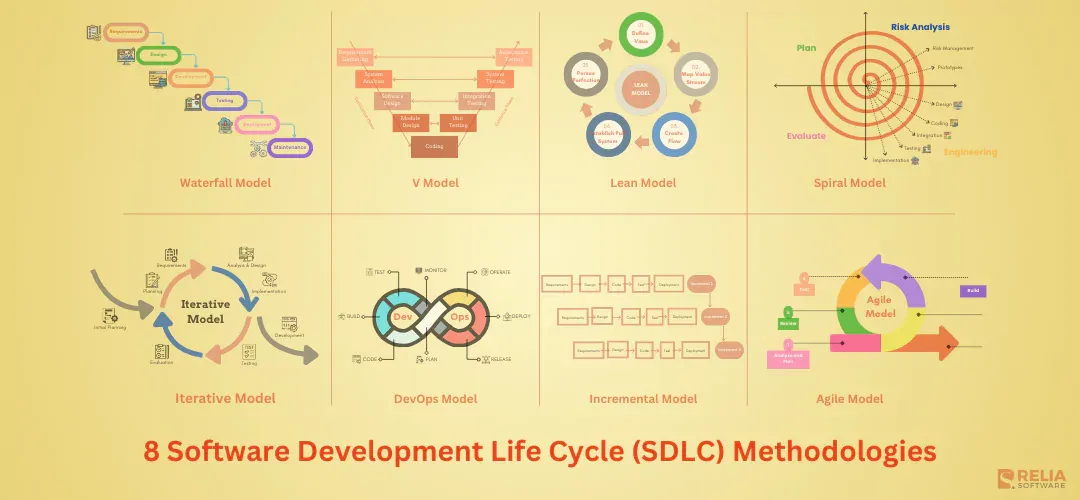The Software Development Life Cycle (SDLC) is a structured process used to design, create, and test software. The road maps guiding this process are SDLC methodologies. Choosing the right method that fits project objectives and needs depends on an awareness of different SDLC models. This tutorial looks at the top SDLC methodologies to enable you to decide wisely for your projects on software development.
What is An SDLC Methodology?
SDLC methodology is a systematic process followed during software development to ensure high-quality and efficient production. It spans planning, analysis, design, development, testing, deployment, and maintenance. Every phase has different uses and helps a software project to be successfully finished.
SDLC methodologies provide a structured approach to software development, helping teams to manage project scope, timelines, and resources effectively. Waterfall, V-Model, Agile, Lean, Iterative, Spiral, Incremental, and DevOps are common methods, each with special traits and uses.
8 Popular SDLC Methodologies
Waterfall Model
The Waterfall Model is the most traditional Software Development Life Cycle (SDLC) methodology. It follows a linear, sequential approach, where each phase of the development process is completed one after another before moving on to the next. This model is like a waterfall; it flows through different stages without going back.
The typical phases include:
- Phase 1: Planning and Requirements Analysis.
- Phase 2: System Design and Architecture.
- Phase 3: Development and Coding.
- Phase 4: Verification and Testing.
- Phase 5: Deployment.
- Phase 6: Maintenance.
The Waterfall Methodology is excellent for projects that have well-defined needs and limited flexibility for change. However, its rigidity causes it unsuitable for complex projects with changing requirements. Here are some excellent scenarios for the waterfall method.
- Create a simple internal business app with defined functions.
- Build a basic e-commerce website with common functionality.
- Develop a retail store POS system with business regulations.
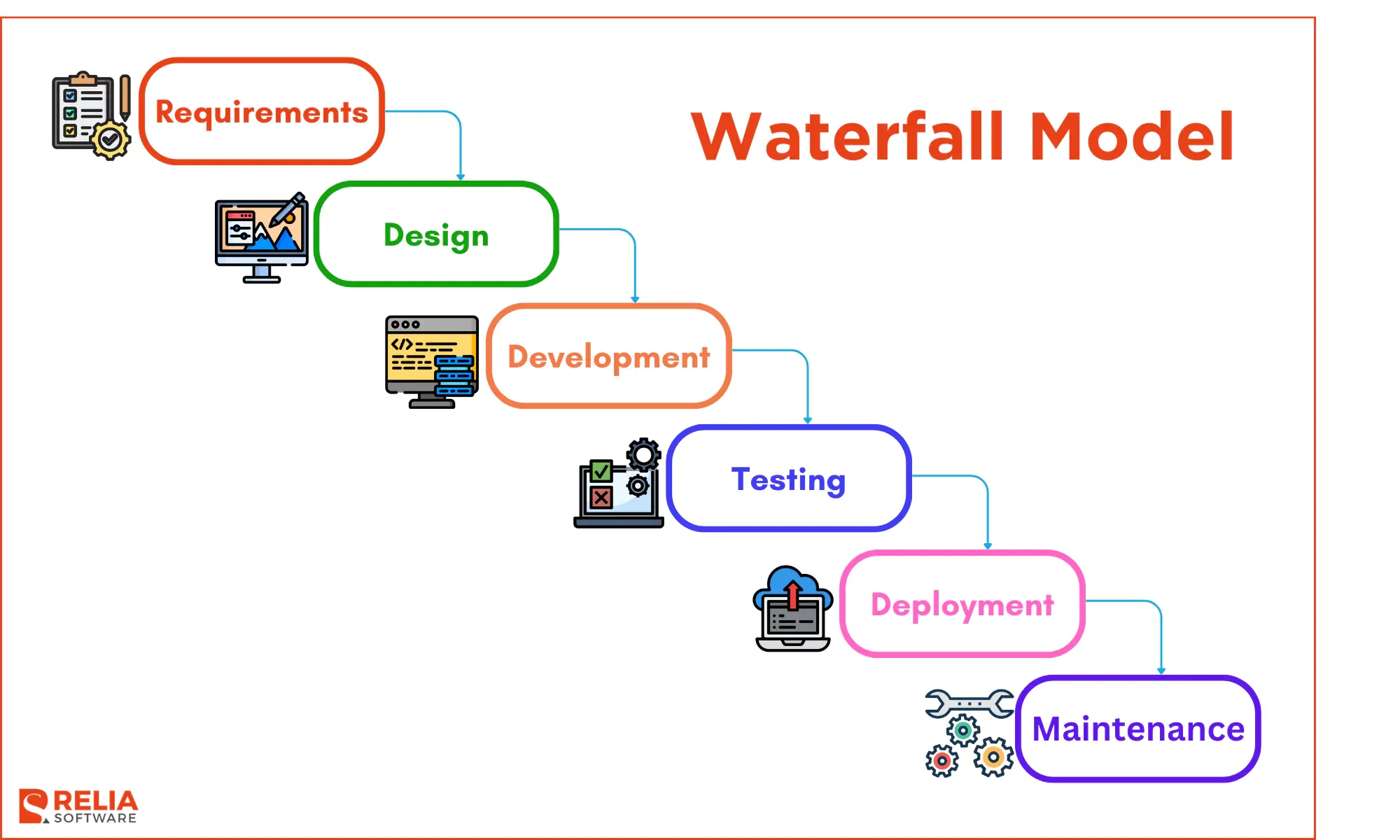
V-Model
The V-Model, also known as the Verification and Validation model, is an extension of the Waterfall model. It underlines the V-shaped lifecycle formed by the parallel relationship of development phases and their related testing phases. Every phase of development has a directly related testing phase that guarantees the integration of validation and verification all through the development process.
The V-Model enhances Waterfall by including verification and validation into every development phase. It fits projects emphasizing quality and dependability. But its rigidity and resource needs make it inappropriate for dynamic or fast-growing applications. Here are some V-model uses:
- Create safety-critical systems like aviation software or medical tools.
- Design embedded systems with high-performance criteria.
- Develop financial solutions that really need security and data integrity.

Iterative Model
>> Read more: In-depth Explanation Of Iterative and Incremental Development
The Iterative Model is a software development approach that builds a system incrementally through repeated cycles (iterations). Unlike the Waterfall Model, in which every step must be finished before the next starts, the Iterative Model goes back over phases allowing for modification depending on feedback and changing needs.
The core principle is to break down the project into smaller, manageable iterations. Typically, each iteration includes planning, requirement specification, design, programming, testing, and deployment. User feedback is received and integrated in the the next iteration.
The Iterative Model is ideal for projects with evolving requirements and a need for user involvement. To prevent being stuck in never-ending iterations, though, good planning and scope management are very vital. Here are some popular use cases for Iterative model:
- Build a new social network site with dynamic features.
- Create a CMS with an expanding set of features.
- Build a complicated e-commerce site with dynamic product features.
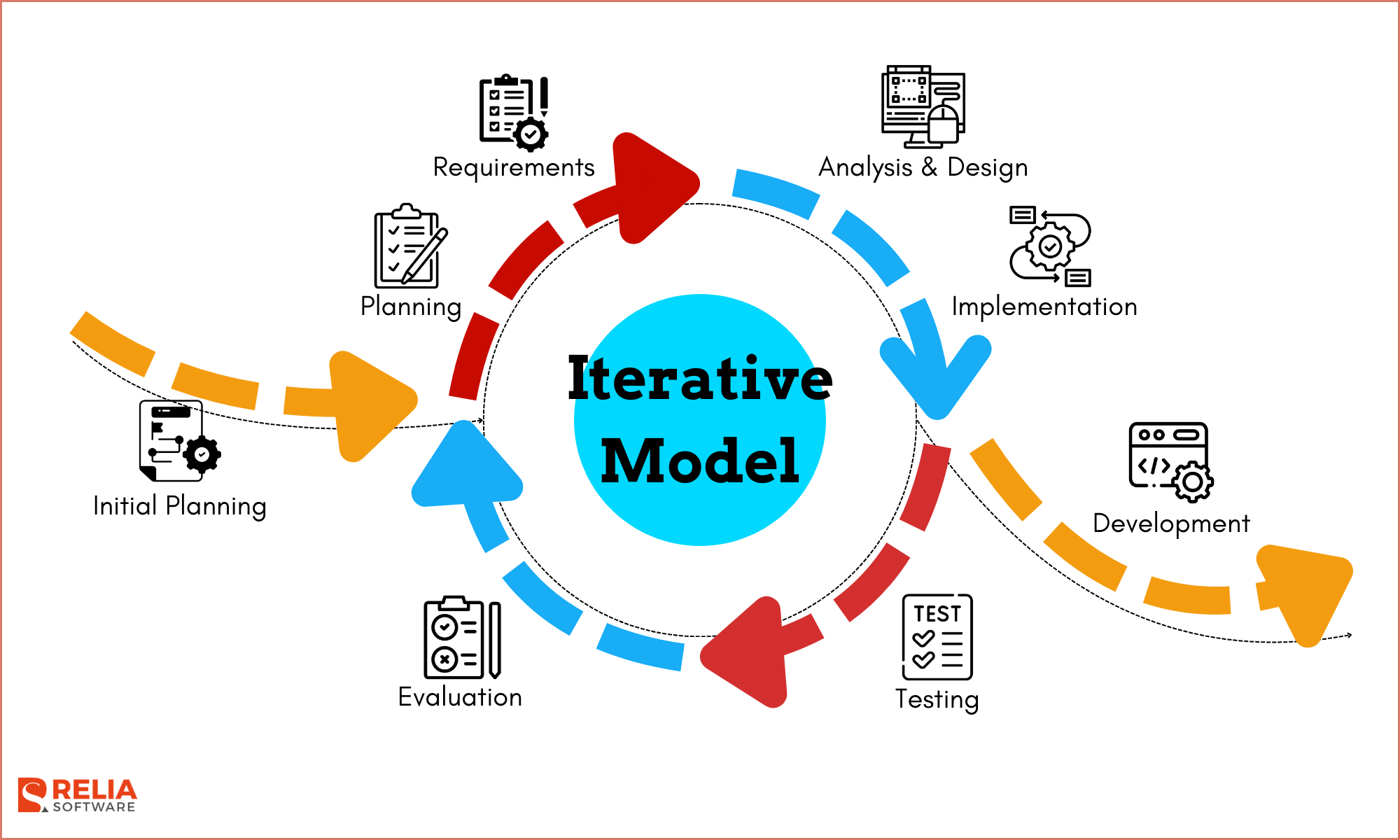
Incremental Model
The Incremental Model divides the system into smaller, manageable increments or parts that are created and delivered in cycles. Users can use useful features early in the process with partial system deployment and early functional component delivery.
It is similar to the Iterative Model but differs in focus. While the Iterative Model improves the product over time, the Incremental Model adds features until the system is complete.
Every increment often follows a mini-waterfall model covering design, planning, development, testing, and deployment. The Incremental Model could be applied, for instance, to build a healthcare management system:
- Initial Planning and Analysis:
- Define overall system requirements.
- Plan the increments and prioritize features.
- Incremental Development and Delivery:
- Increment 1:
- Planning: Identify essential features such as patient registration and appointment scheduling.
- Development: Develop the patient registration module.
- Testing: Conduct unit testing on the patient registration module.
- Delivery: Deploy the system with basic functionality.
- Evaluation: Collect feedback from healthcare providers.
- Increment 2:
- Planning: Plan for adding electronic health records (EHR) management.
- Development: Implement EHR management functionality.
- Testing: Perform integration testing with the patient registration module.
- Delivery: Release the updated system with EHR management.
- Evaluation: Gather feedback on EHR usability.
- Increment 3:
- Planning: Add features for billing and insurance processing.
- Development: Develop billing and insurance modules.
- Testing: Test the new modules and ensure compatibility with existing features.
- Delivery: Deploy the system with full billing and insurance processing capabilities.
- Evaluation: Review system performance and user feedback.
- Increment 1:
>> Read more about Healthcare software:
- Key Benefits of Healthcare Automation Systems
- Top 8 Healthcare Apps For Patients & Clinics
- Data Security in Healthcare Software: Why Is It Important?
- Tips for Enhancing Healthcare UI Design in Mobile Apps
The Incremental Model works well for projects with specified functions and phased deployment. For example:
- Create a POS system including sales, inventory, and CRM components.
- Build a learning management system (LMS) with features like course creation, student enrollment, and progress tracking, then deliver them in phases.
- Develop a complex ERP system integrating financial, HR, and supply chain management components.
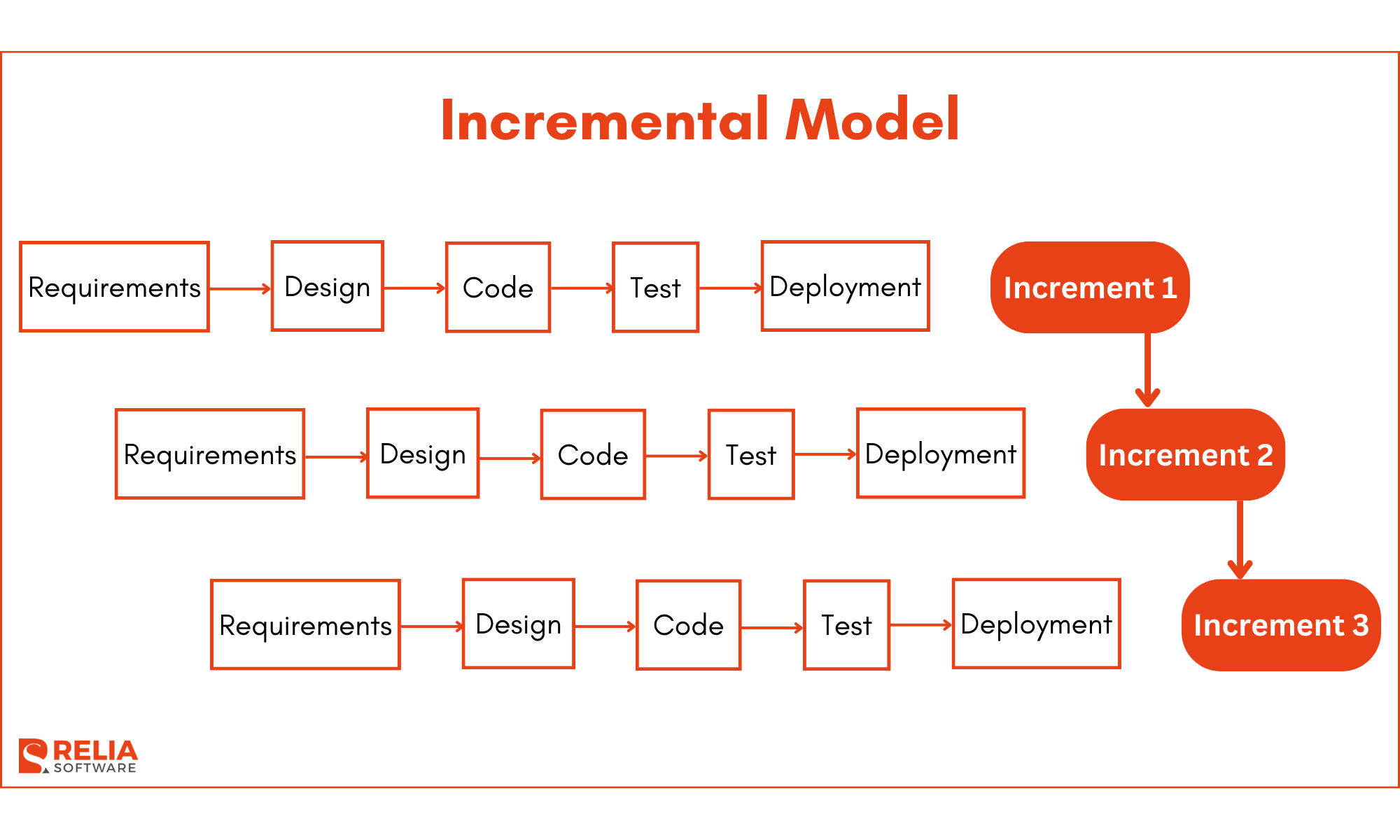
Spiral Model
The Spiral Model is a risk-driven software development process model that combines elements of both iterative and incremental models. It emphasizes continuous risk assessment and iterative refinement through a series of spirals, or cycles, each encompassing four main phases:
- Planning: Define objectives, identify constraints, and determine alternatives.
- Risk Analysis: Identify and evaluate risks, develop mitigation strategies, and prototype possible solutions.
- Engineering: Create and test the next level of the product while implementing recognized solutions.
- Evaluation: Assess the progress, plan the next iteration, and gather stakeholder feedback.
In short, the Spiral Model emphasizes building prototypes and gathering feedback throughout the development process. Let's look at a Spiral Model-based Large-Scale Enterprise System to learn how it works.
-
Iteration 1:
- Planning: Identify basic requirements, such as user management and data storage.
- Risk Analysis: Assess risks related to data security and scalability.
- Engineering: Develop a prototype for the user management module.
- Evaluation: Test the prototype, gather user feedback, and plan the next iteration.
-
Iteration 2:
- Planning: Focus on the ability to conduct transactions.
- Risk Analysis: Determine and reduce the transaction integrity and performance concerns.
- Engineering: Develop and integrate the transaction processing module.
- Evaluation: Assess system performance, get feedback, and make plans for future improvements.
- Planning: Focus on the ability to conduct transactions.
The Spiral Model is well-suited for large and complex projects with high-risk factors and need for early user feedback. For instance:
- Developing a new online banking system with complex security and regulatory requirements.
- Building a large enterprise software application with constantly evolving functionalities.
- Creating a medical device with critical safety considerations, where early risk identification is paramount.
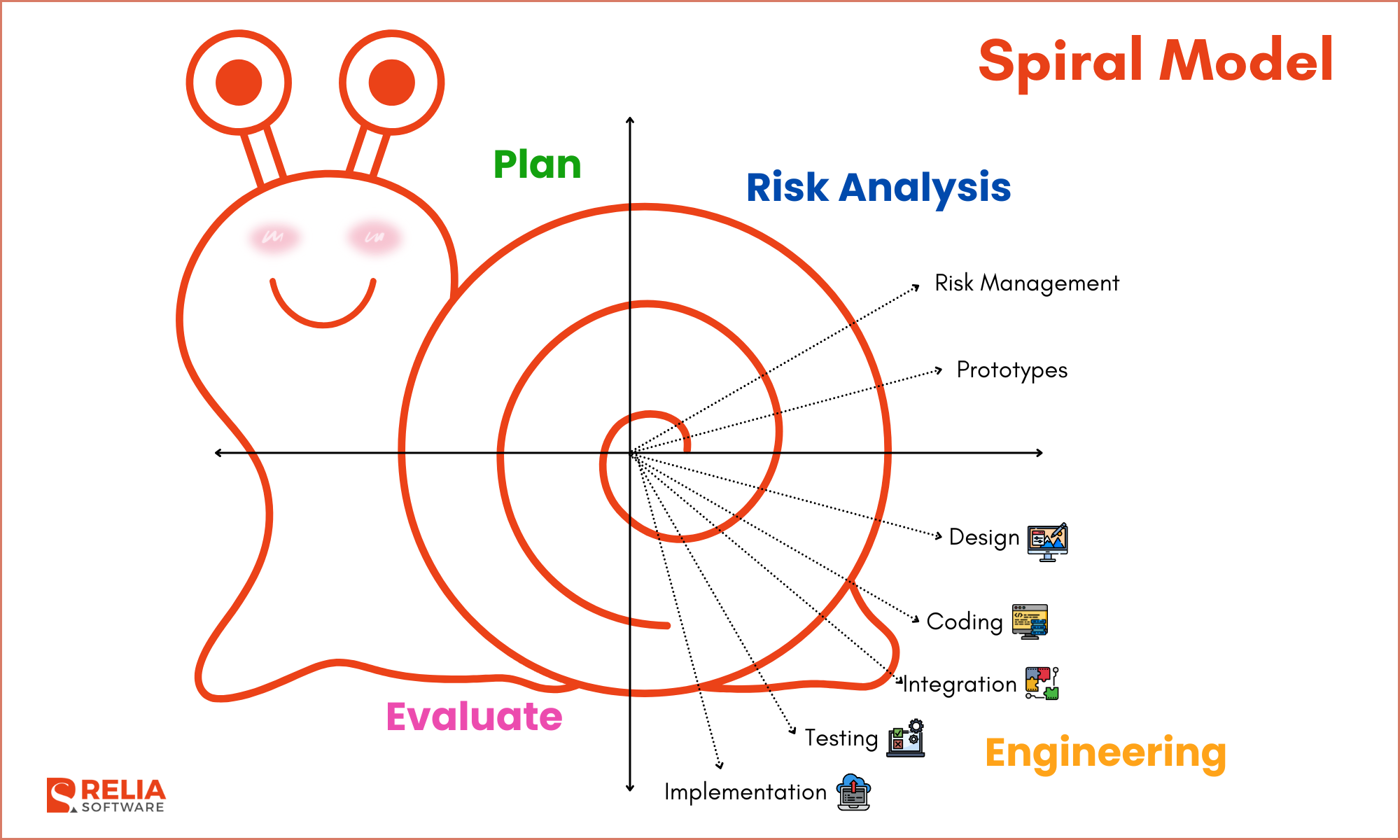
Agile Model
The Agile Model is a flexible and iterative approach to software development. Collaboration, customer feedback, and rapid product delivery are the key features of the Agile Model. Through continuous iterations, it adapts to changing requirements and delivers small, incremental improvements.
Let’s visualize how Agile method works via a practical example below:
Development of a Mobile Banking App
-
Sprint 1:
- Planning: Define and prioritize features such as account balance viewing and transaction history.
- Development: Implement and test account balance feature.
- Review: Demonstrate the feature to stakeholders, gather feedback.
- Retrospective: Discuss what went well and what can be improved.
-
Sprint 2:
- Planning: Focus on transaction history feature.
- Development: Implement and integrate transaction history functionality.
- Review: Present the updated app to stakeholders, collect feedback.
- Retrospective: Identify improvements for the next sprint.
The Agile Model is well-suited for projects with evolving requirements, need for rapid feedback, and uncertain technologies. Examples:
- Developing a mobile app with constantly evolving features based on user feedback.
- Building a web application where user needs and market demands are constantly changing.
- Creating a complex software product with a high degree of uncertainty about the final requirements.
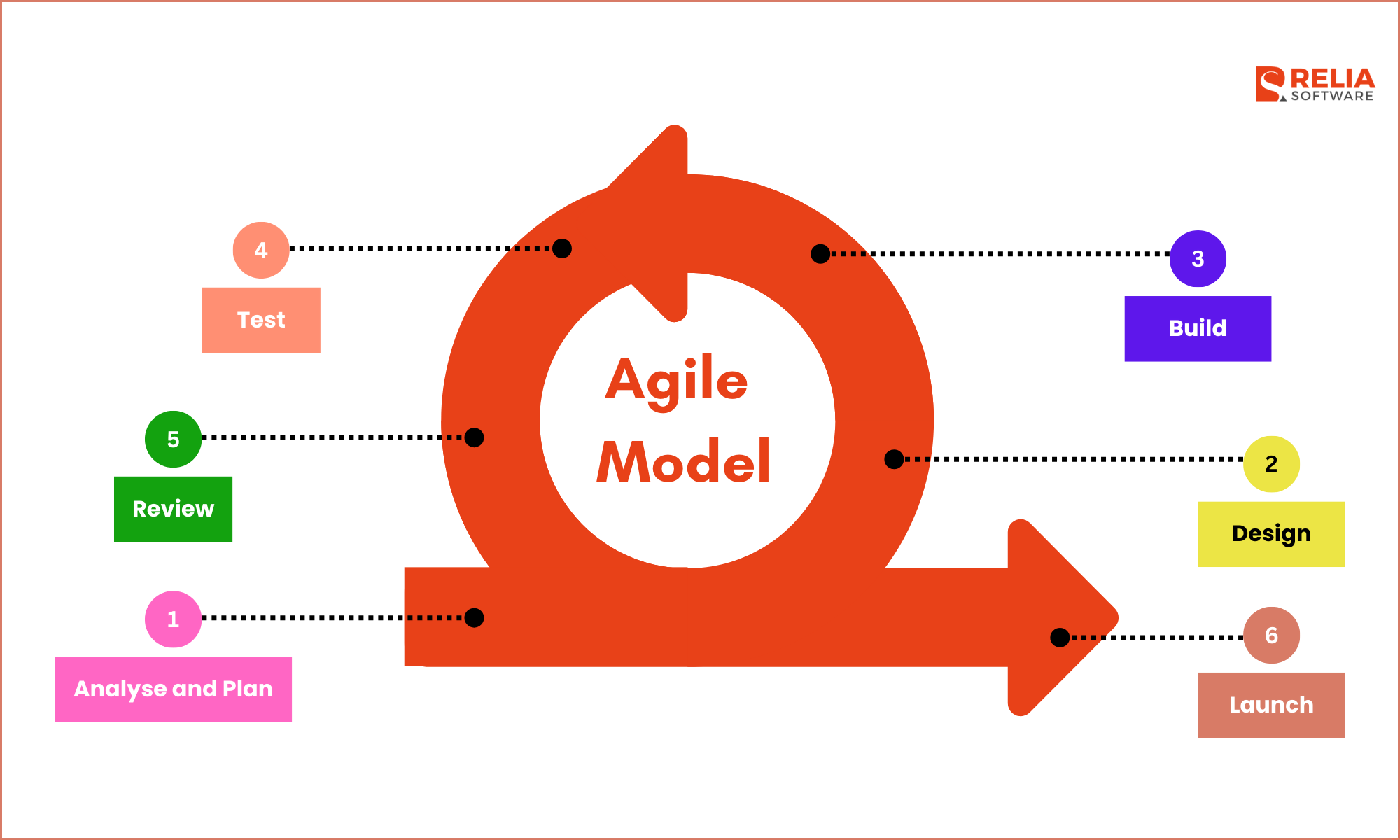
Lean Model
The Lean Model is a software development approach derived from lean manufacturing principles. It focuses on delivering maximum value to the customer by minimizing waste and optimizing processes.
The core principles of the Lean Model include:
- Value: Determine what is actually valuable to the client and the company. Concentrate on effectively providing that value.
- Eliminate Waste: Determine which activities—including those involving time, materials, resources, and effort—do not bring value and eliminate them.
- Build Quality In: Integrate quality assurance into the development process, preventing defects from the outset, rather than fixing them later.
- Create Knowledge: Promote continuous learning and knowledge sharing.
- Defer Commitment: Wait until the last minute to make judgments that cannot be altered.
- Deliver Fast: Deliver small, incremental releases quickly.
- Respect People: Encourage cooperation, empower team members, and acknowledge their contributions.
- Optimize the Whole: Focus on improving the entire workflow, not just individual parts.
Several tools and techniques support the implementation of Lean principles:
- Value Stream Mapping: Visually map the entire process flow to identify potential areas of waste and inefficiency.
- Kanban Boards: Visualize workflow stages and limit work in progress (WIP) to improve efficiency.
- 5S Methodology: A workplace organization system that emphasizes Sort, Set in Order, Shine, Standardize, and Sustain.
- Kaizen Events: Dedicated brainstorming sessions focused on identifying and eliminating waste within a specific process.

DevOps Model
The DevOps Model is a software development method that puts together development (Dev) and operations (Ops) teams to make them work better together. Its aims are to improve collaboration, automate processes, and use continuous integration and delivery (CI/CD) to deliver high-quality software faster. Shared tools and streamlined workflows are key to making the development process more efficient.
>> Read more about DevOps:
- CI/CD vs DevOps: Key Differences & How They Work Together?
- Top 9 Best DevOps Deployment Tools for Businesses
- DataOps vs DevOps: Similarities, Differences & Use Cases
- Top 22 Best DevOps Automation Tools For Businesses
- 7 Ways DevOps Speeds Up the Digital Transformation
Look through a practical example of a web application development process based on DevOps:
- Collaboration: Development and operations teams work together to plan, build, and deploy the application.
- Automation: Automate testing and deployment using tools like Jenkins, GitLab CI, or CircleCI in CI/CD pipelines.
- Continuous Integration: Developers commit code to a shared repository, initiating automated builds and tests.
- Continuous Delivery: Every successful build is automatically deployed, allowing the program to be released anytime.
- Monitoring: Use tools like Prometheus and Grafana for continuous monitoring and alerting to track application performance and health.
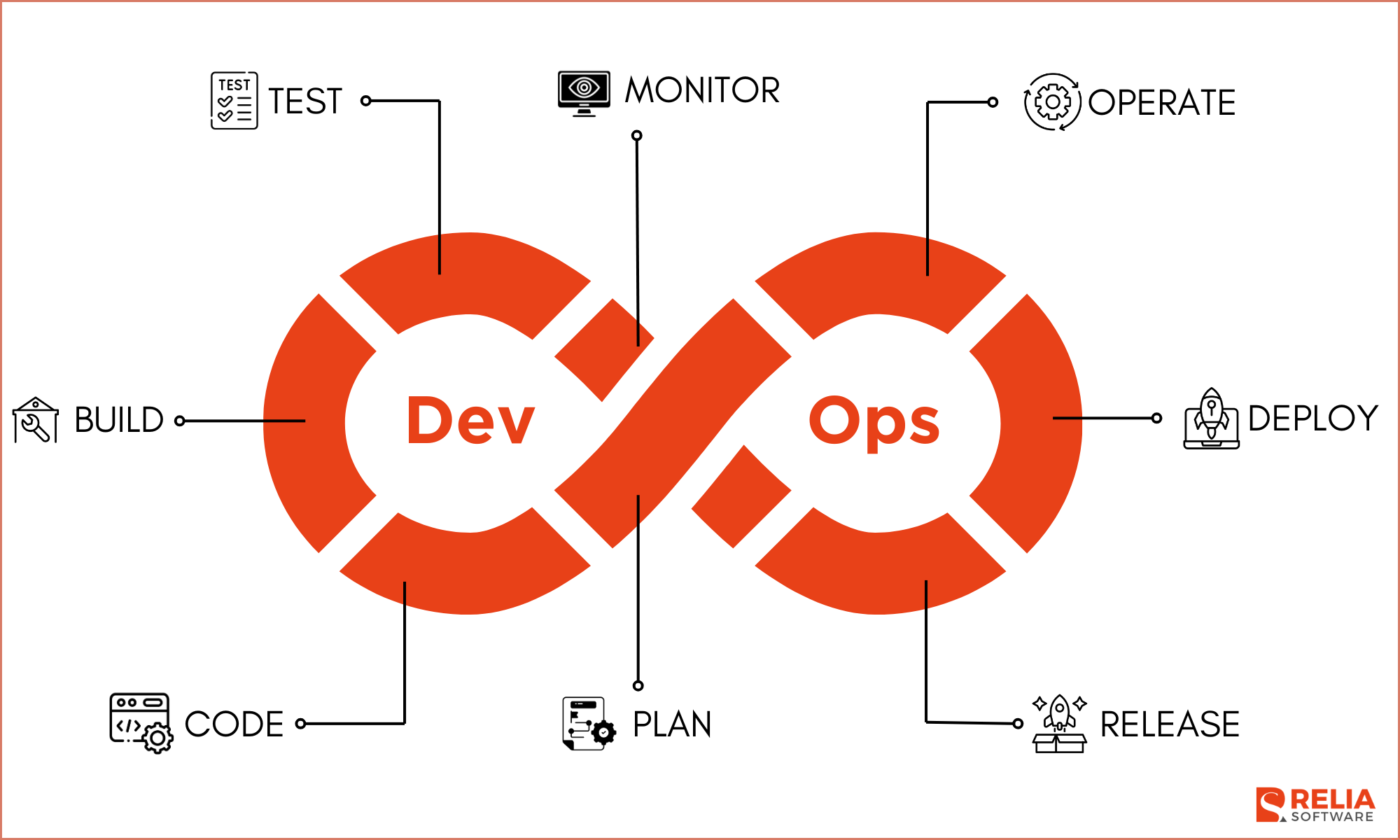
Below is the Comparison Table of Key Factors for 8 SDLC Methodologies:
| Factor | Waterfall Model | V-Model | Iterative Model | Incremental Model | Spiral Model | Agile Model | Lean Model | DevOps Model |
|---|---|---|---|---|---|---|---|---|
| Approach | Linear and Sequential | Linear with Verification and Validation | Repeated Cycles | Successive Increments | Risk-Driven Cycles | Iterative and Incremental | Value and Waste Minimization | Integration of Development and Operations |
| Flexibility | Low | Low | High | Medium | High | Very High | High | High |
| Customer Involvement | Low | Low | Medium | High | High | Very High | High | High |
| Risk Management | Low | Medium | Medium | Medium | Very High | Medium | High | High |
| Documentation | Extensive | Extensive | Varies | Varies | Varies | Light to Medium | Light to Medium | Light |
| Iteration Duration | Long | Long | Short to Medium | Short to Medium | Medium to Long | Short | Short | Short |
| Development Speed | Slow | Slow | Moderate | Moderate | Moderate | Fast | Moderate | Fast |
| Testing | Post-development | Throughout Development | Continuous | Continuous | Continuous | Continuous | Continuous | Continuous |
|
Best Suited For | Well-defined Requirements | Well-defined Requirements | Evolving Requirements | Complex Projects | Large and Complex Projects | Dynamic and Changing Requirements | Efficiency and Value-focused Projects | Continuous Deployment and Rapid Iteration |
>> Read more: Product Metrics in Software Engineering: Types, Techniques, Tools
Final Thoughts
The world of software development offers a wide range of methodologies, each with its strengths and considerations. The choice of SDLC model significantly impacts the success of a software project.
Waterfall and V-Models are appropriate for well-defined projects, whereas iterative and incremental models handle changing needs. Spiral excels at risk management, Agile and Lean encourage flexibility and efficiency, while DevOps focuses on continuous integration and deployment. Understanding these models assists in determining the optimal way for producing high-quality software that satisfies user needs efficiently.
>>> Follow and Contact Relia Software for more information!
- development
